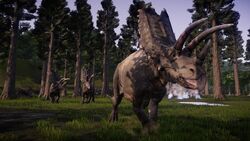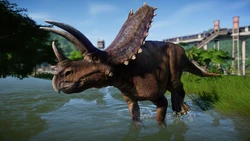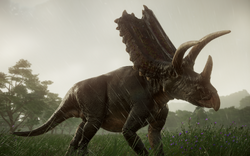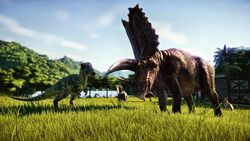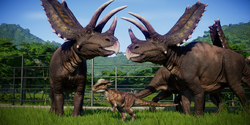| So the Pentaceratops here, it has five horns. One on the nose. Two on the brows. And two extending out from its jugular bones. It seems... excessive. But maybe it's necessary. |
Pentaceratops is a genus of ceratopsid dinosaur that originated from Late Cretaceous North America. Pentaceratops fossils are first unlocked on Isla Sorna then excavated in the Dinosaur Park Formation and Kirtland Formation.
Characteristics
The game's tallest ceratopsian, measuring between six and eight meters in length and weighing in excess of five tons, Pentaceratops towers above its relatives such as Torosaurus and Styracosaurus. As such, Pentaceratops bears a strong resemblance to its more famous cousin Triceratops – although, as the name (which translates to "Five-Horned Face") suggests, it has five horns instead of three. Pentaceratops has a huge frill crowned with bony horn-like growths and three large horns; one on its snout and two above its eyes. It used a tough beak with a tooth battery in its upper jaw to consume vegetation like palms and horsetails. Pentaceratops has an eye-catching frill protruding from the back of its skull that helps it to attract a mate. The dinosaur's base cosmetic genome is a rusty brown with dark blue and purple on its frill.
Unlocked near the end of the campaign, Pentaceratops has above average requirements but is otherwise relatively easy to take care of.
Behaviour
Like all other ceratopsians, Pentaceratops will engage in a death duel with large and medium carnivores such as Spinosaurus and Majungasaurus if provoked.
Pentaceratops is a moderately social animal and requires at least two more of its own kind to maintain a healthy comfort level but otherwise has a very low maximum social and population limit. Additionally, Pentaceratops is capable of living somewhat peacefully alongside small carnivores such as Dilophosaurus and Troodon, only occasionally engaging in non-fatal territorial fights.
Pentaceratops will, as all herbivores do, socialize with others of its own species on occasion, but otherwise behaves very similarly to other ceratopsians.
Paleontology
Pentaceratops was first discovered by American fossil collector and paleontologist Charles Hazelius Sternberg in 1921, having unearthed multiple fossils from the Kirtland Formation near the San Juan Basin in New Mexico. Working on commission for the Swedish Uppsala University, Sternberg recovered a skull and rump, specimens PMU R.200 and PMU R.286, at the Meyers Creek near the Kimbetoh Wash in a layer of the Kirtland Formation. Later, in 1922, Sternberg began a dig in the Fossil Forest of San Juan County, New Mexico, where he discovered a complete skeleton of the dinosaur. Exploration of the area led to further findings, and Pentaceratops was officially classified as a new genus by Henry Fairfield Osborn in 1923.
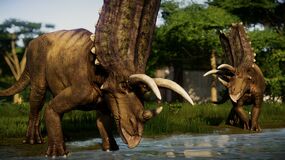
A pair of Pentaceratops.
Although one of the larger ceratopsids of the Mesozoic Period, in-game, Pentaceratops is larger than its real-life counterpart.
Despite its name, the knobs on the side of the Pentaceratops head were determined to be outgrowths of the dinosaur's cheekbones rather than genuine horns.
Paleoecology
Pentaceratops existed during the Late Cretaceous period, around 75 million years ago, and on the vast plains of the western United States, feeding mainly on plants and shrubs. It lived alongside numerous other dinosaurs such as the hadrosaurs Edmontosaurus and Parasaurolophus, the Pachycephalosauridae Sphaerotholus, the armored ankylosauridae Nodocephalosaurus, and the tyrannosaurid Bistahieversor. The Kirtland Formation did not have many species of flowering plants and instead older plant types from the Mesozoic, such as cycads and ferns, still dominated the dinosaur's environment. It was formed from alluvial mud and sand deposits draining the coastal plain on the inland shore of North America.
Available genomes
| Fossil icon | Dig site | Quality | Number available |
|---|---|---|---|
| Dinosaur Park Formation | ★ ★★ ★★★ ★★★★ |
1 3 6 4 | |
| Kirtland Formation | ★ ★★ ★★★ ★★★★ |
1 3 6 4 |
Skins
Gallery
External links
- Pentaceratops on Wikipedia








